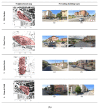Reliability of T-WSI to Evaluate Neighborhoods Walkability and Its Changes over Time
- PMID: 33105601
- PMCID: PMC7659927
- DOI: 10.3390/ijerph17217709
Reliability of T-WSI to Evaluate Neighborhoods Walkability and Its Changes over Time
Abstract
More walkable neighborhoods are linked to increased physical activity. The Walking Suitability Index of the territory (T-WSI) is an easy method to evaluate walkability on the basis of direct observation. T-WSI provides 12 indicators divided into 4 categories (practicability, safety, urbanity, pleasantness); the weighted analysis of these indicators gives an overall score of the actual usability of the neighborhood. The aim of the study is to evaluate the ability of T-WSI' indicators to measure, in a reliable way, any street's walkability variations occurred over time. The investigation was performed in 2018 in nine urban neighborhoods of Rieti city. Cronbach's α is used to evaluate internal consistency of T-WSI; Intraclass Correlation Coefficient (ICC) is used to evaluate the reproducibility of measurements (or ratings) made by different investigators. Cronbach's α is 0.89 (± 0.02); ICC is also good (ICC = 0.89; 95% CI: 0.84-0.92). The results of the 2018 investigation are also compared with those collected in 2016 in the same districts. The results show that T-WSI is a reliable and easy to use tool, useful to measure the effectiveness of the interventions already realized at local level, but it could also contribute to making decisions to develop regeneration projects.
Keywords: healthy urban planning; physical activity; reliability; reproducibility; walkable neighborhoods.
Conflict of interest statement
The authors declare no conflict of interest.
Figures




References
-
- EEA. [(accessed on 20 August 2020)];2017 Available online: http://www.eea.europa.eu/it/themes/urban/intro.
-
- Rydin Y., Bleahu A., Davies M., Dávila J.D., Friel S., De Grandis G., Groce N., Hallal P.C., Hamilton I., Howden-Chapman P., et al. Shaping cities for health: Complexity and the planning of urban environments in the 21st century. Lancet. 2012;379:2079–2108. doi: 10.1016/S0140-6736(12)60435-8. - DOI - PMC - PubMed
-
- D’Alessandro D., Arletti S., Azara A., Buffoli M., Capasso L., Cappuccitti A., Casuccio A., Cecchini A., Costa G., De Martino A.M., et al. Strategies for Disease Prevention and Health Promotion in Urban Areas: The Erice 50 Charter. Ann. Ig. Med. Prev. Comunita. 2017;29:481–493. doi: 10.1093/eurpub/cky212.600. - DOI - PubMed
-
- WHO . Saving Lives, Spending Less: A Strategic Response to Noncommunicable Diseases. World Health Organization; Geneva, Switzerland: 2018.
MeSH terms
LinkOut - more resources
Full Text Sources

